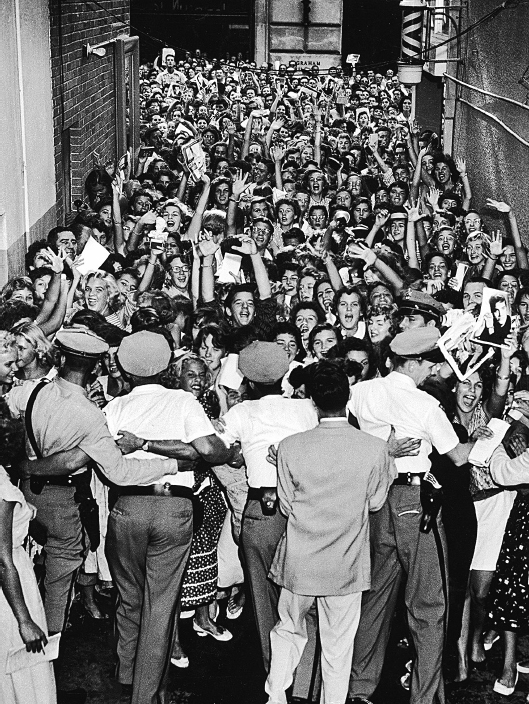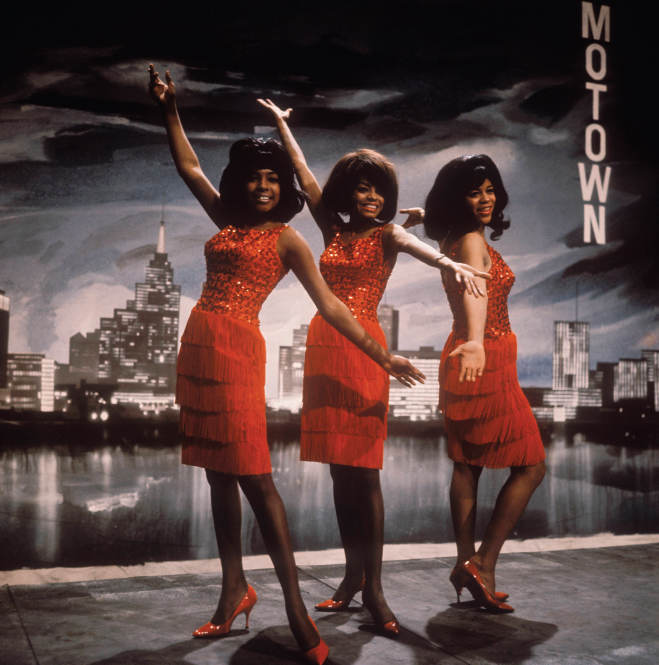America’s History: Printed Page 847
America: A Concise History: Printed Page 769
America’s History: Value Edition: Printed Page 749
Youth Culture

One of the most striking developments in American life in the postwar decades was the emergence of the teenager as a cultural phenomenon. In 1956, only partly in jest, the CBS radio commentator Eric Sevareid questioned “whether the teenagers will take over the United States lock, stock, living room, and garage.” Sevareid was grumbling about American youth culture, a phenomenon first noticed in the 1920s and with its roots in the lengthening years of education, the role of peer groups, and the consumer tastes of young people. Market research revealed a distinct teen market to be exploited. Newsweek noted with awe in 1951 that the aggregate of the weekly spending money of teenagers was enough to buy 190 million candy bars, 130 million soft drinks, and 230 million sticks of gum. Increasingly, advertisers targeted the young, both to capture their spending money and to exploit their influence on family purchases.
Hollywood movies played a large role in fostering a teenage culture. Young people made up the largest audience for motion pictures, and Hollywood studios learned over the course of the 1950s to cater to them. The success of films such as The Wild One (1953), starring Marlon Brando; Blackboard Jungle (1955), with Sidney Poitier; and Rebel Without a Cause (1955), starring James Dean, convinced movie executives that films directed at teenagers were worthy investments. “What are you rebelling against?” Brando is asked in The Wild One. “Whattaya got?” he replies. By the early 1960s, Hollywood had retooled its business model, shifting emphasis away from adults and families to teenagers. The “teenpic” soon included multiple genres: horror, rock ’n’ roll, dangerous youth, and beach party, among others.
Rock ’n’ Roll What really defined the youth culture, however, was its music. Rejecting the romantic ballads of the 1940s, teenagers discovered rock ’n’ roll, which originated in African American rhythm and blues. The Cleveland disc jockey Alan Freed took the lead in introducing white America to the black-created sound by playing what were called “race” records. “If I could find a white man who had the Negro sound and the Negro feel, I could make a billion dollars,” a record company owner is quoted as saying. The performer who fit that bill was Elvis Presley, who rocketed into instant celebrity in 1956 with his hit records “Hound Dog” and “Heartbreak Hotel,” covers of songs originally recorded by black artists such as Big Mama Thornton. Between 1953 and 1959, record sales increased from $213 million to $603 million, with rock ’n’ roll as the driving force.

Many unhappy adults saw in rock ’n’ roll music an invitation to interracial dating, rebellion, and a more flagrant sexuality. The media featured hundreds of stories on problem teens, and denunciations of the new music poured forth from many corners. Such condemnation only deflected off the new youth culture or, if anything, increased its popularity. Both Hollywood and the music industry had learned that youth rebellion sold tickets.
Cultural Dissenters Youth rebellion was only one aspect of a broader discontent with the sometimes saccharine consumer culture of the 1950s. Many artists, writers, and jazz musicians embarked on powerful new experimental projects in a remarkable flowering of intensely personal, introspective art forms. Black musicians developed a hard-driving improvisational style known as bebop. Whether the “hot” bebop of saxophonist Charlie Parker or the more subdued “cool” sound of the influential trumpeter Miles Davis, postwar jazz was cerebral, intimate, and individualistic. As such, it stood in stark contrast to the commercialized, dance-oriented “swing” bands of the 1930s and 1940s.
Black jazz musicians found eager fans not only in the African American community but also among young white Beats, a group of writers and poets centered in New York and San Francisco who disdained middle-class materialism. In his poem “Howl” (1956), which became a manifesto of the Beat generation, Allen Ginsberg lamented: “I saw the best minds of my generation destroyed by madness, starving hysterical naked, dragging themselves through the negro streets at dawn looking for an angry fix.” In works such as Jack Kerouac’s novel On the Road (1957), the Beats glorified spontaneity, sexual adventurism, drug use, and spirituality. The Beats were apolitical, but their cultural rebellion would, in the 1960s, inspire a new generation of young rebels disenchanted with both the political and cultural status quo.
UNDERSTAND POINTS OF VIEW
Question
How did rebellion become an integral part of consumer culture in the postwar period?